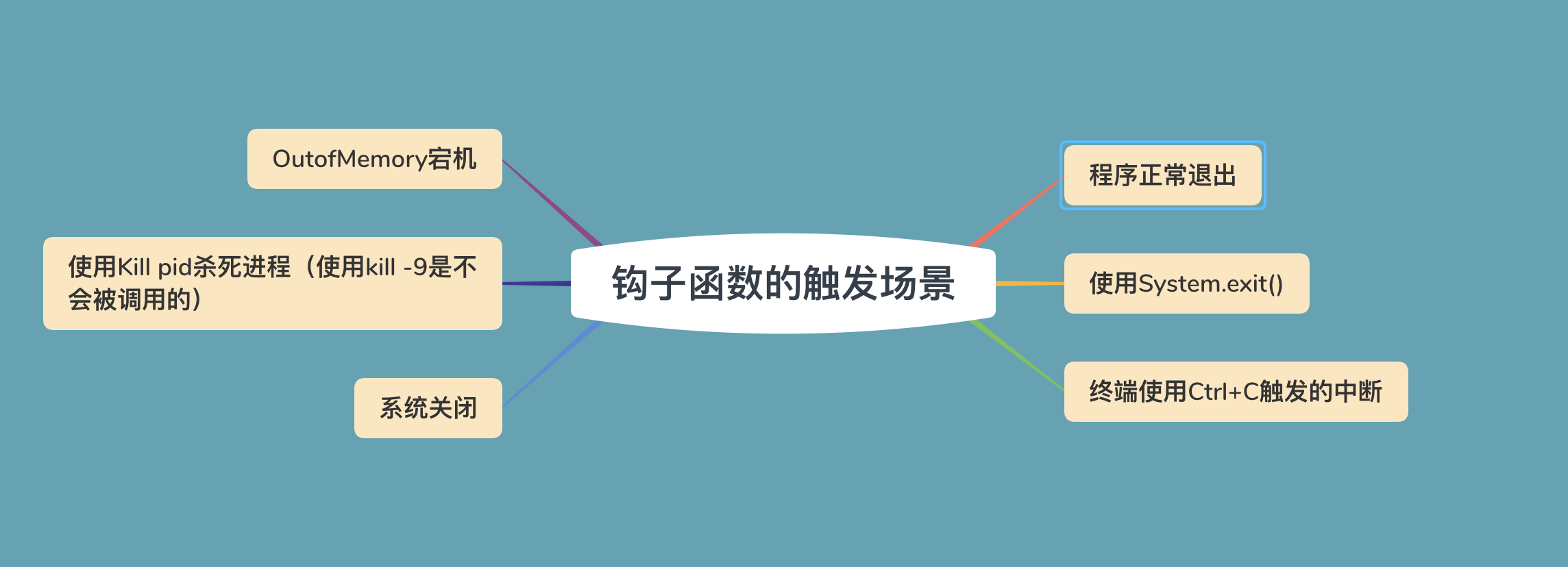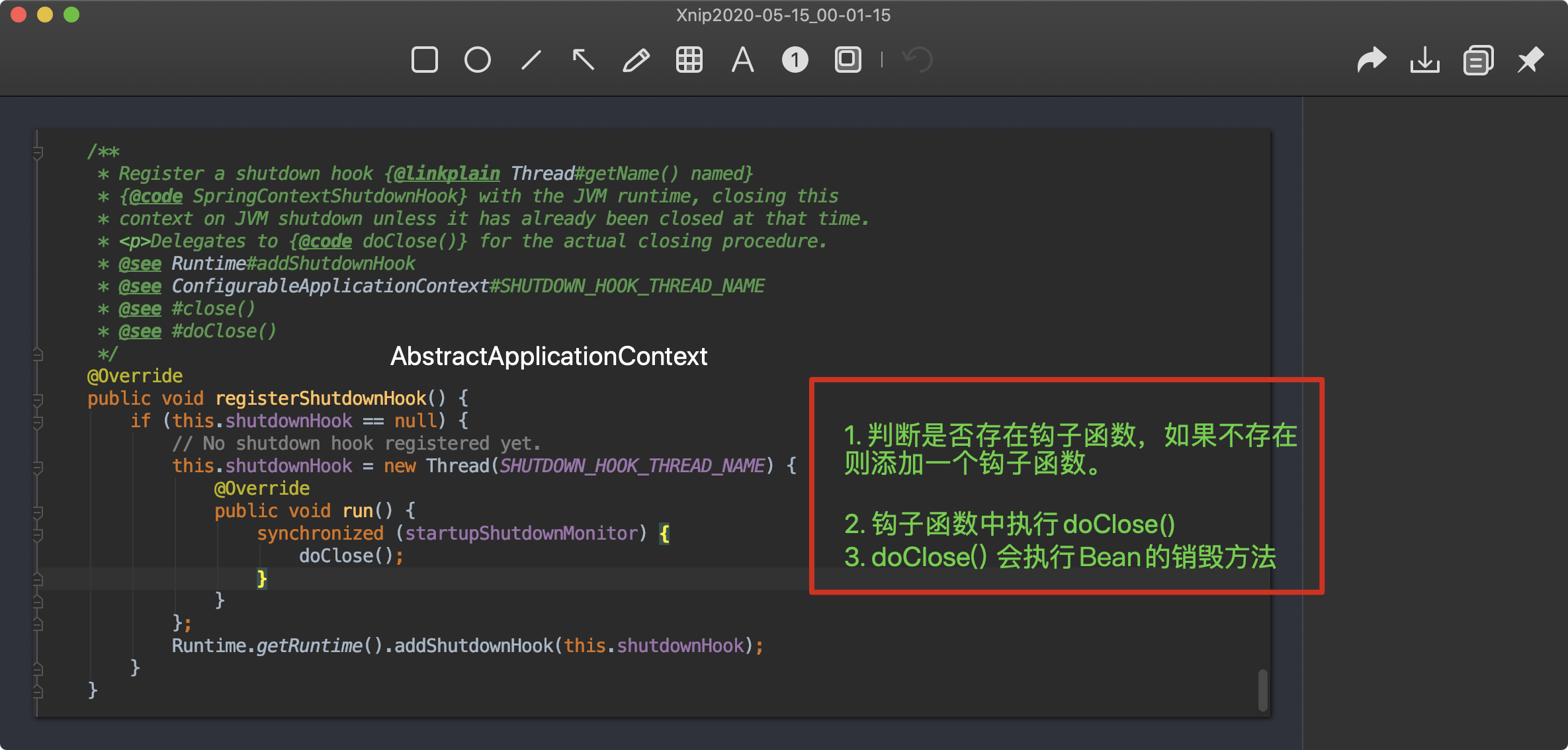JVM钩子hooks函数

作者: 西魏陶渊明 博客: https://blog.springlearn.cn/ (opens new window)
西魏陶渊明
莫笑少年江湖梦,谁不少年梦江湖
什么是钩子函数,在学习钩子函数之前,小编先提一个问题。
请问在Spring中,如果JVM异常终止,Spring是如何保证会释放掉占用的资源,比如说数据库连接等资源呢?
钩子函数非常简单,简单到小编只用摘抄一段Spring代码即可。走你,现在开始。
# 问题
Spring 容器中 Bean 在什么时候执行销毁方法?
我们知道在Spring中定义销毁方法有两种方式
- 实现
DisposableBean的destroy方法。 - 使用
@PreDestroy注解修饰方法
@Component
public class DataCollectBean implements DisposableBean {
/**
* 第一种方法实现 DisposableBean#destroy方法
*
* @throws Exception 异常
*/
@Override
public void destroy() throws Exception {
System.err.println("执行销毁方法");
}
/**
* 第二种方法使用PreDestroy注解声明销毁方法
*/
@PreDestroy
public void customerDestroy() {
System.err.println("执行自定义销毁方法");
}
}
2
3
4
5
6
7
8
9
10
11
12
13
14
15
16
17
18
19
20
21
22
23
24
# 那么在什么时候执行销毁方法?

- 主动执行销毁bean
public static void main(String[] args) {
ConfigurableApplicationContext run = SpringApplication.run(DemoApplication.class, args);
DataCollectBean bean = run.getBean(DataCollectBean.class);
//1. 主动销毁bean
run.getBeanFactory().destroyBean(bean);
}
2
3
4
5
6
- JVM关闭时候自动执行销毁方法。
这里就要用到钩子函数了, Spring 的钩子函数在 AbstractApplicationContext#shutdownHook属性
如果我们是SpringBoot项目我们看到在SpringApplication启动时候会注册一个钩子函数

# 如何定义钩子函数?
简直太简单了,没有任何学习成本。一行代码就能搞定。
public class HooksTester {
public static void main(String[] args) {
Runtime.getRuntime().addShutdownHook(new Thread(new Runnable() {
@Override
public void run() {
System.out.println("钩子函数执行");
}
}));
//当主动关闭应用
while (true);
}
}
2
3
4
5
6
7
8
9
10
11
12

# 触发钩子函数的场景
只要不是机器断电,强制kill -9 强制杀进程,都会触发。

# 钩子函数能做什么?

正如上图所示优雅停机,在项目将要关闭时候,主动释放程序占用的资源信息,释放db连接池的连接等其他占用的资源信息。
如果我们是 Spring 项目其实我们不用自己定义钩子函数,我们只要使用Spring提供给我们的销毁方法即可。因为
Spring定义的钩子函数中会去执行, DisposableBean.destory() 和被 PreDestroy 修饰的方法。
我们看下源码

protected void doClose() {
// Check whether an actual close attempt is necessary...
if (this.active.get() && this.closed.compareAndSet(false, true)) {
if (logger.isDebugEnabled()) {
logger.debug("Closing " + this);
}
LiveBeansView.unregisterApplicationContext(this);
try {
// Publish shutdown event.
publishEvent(new ContextClosedEvent(this));
}
catch (Throwable ex) {
logger.warn("Exception thrown from ApplicationListener handling ContextClosedEvent", ex);
}
// Stop all Lifecycle beans, to avoid delays during individual destruction.
if (this.lifecycleProcessor != null) {
try {
this.lifecycleProcessor.onClose();
}
catch (Throwable ex) {
logger.warn("Exception thrown from LifecycleProcessor on context close", ex);
}
}
// Destroy all cached singletons in the context's BeanFactory.
destroyBeans();
// Close the state of this context itself.
closeBeanFactory();
// Let subclasses do some final clean-up if they wish...
onClose();
// Reset local application listeners to pre-refresh state.
if (this.earlyApplicationListeners != null) {
this.applicationListeners.clear();
this.applicationListeners.addAll(this.earlyApplicationListeners);
}
// Switch to inactive.
this.active.set(false);
}
}
2
3
4
5
6
7
8
9
10
11
12
13
14
15
16
17
18
19
20
21
22
23
24
25
26
27
28
29
30
31
32
33
34
35
36
37
38
39
40
41
42
43
44
45
46
可以看到:doClose()方法会执行bean的destroy(),也会执行SmartLifeCycle的stop()方法,我们就可以通过重写这些方法来实现对象的关闭,生命周期的管理,实现平滑shutdown
最后求关注,求订阅,谢谢你的阅读!



